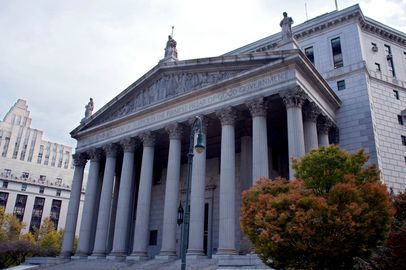

The New York County Courthouse is actually better known as the New York Supreme Court, a trial court that has unlimited jurisdiction in civil and criminal cases. The hexagonal granite building is massive and formidable, just like the American legal system, but stylistically it is an unfortunate hodgepodge and its color - let's admit - is rather dreary. It also seems to be surmounting the elegant colonnade, creating a sense of disharmony, especially if viewed from afar.
The building was designed Guy Lowell and built between 1913 and 1927, with long delays caused by World War I. Inspired by ancient Greek and Roman architecture, the colonnade takes up most of the façade. Above the columns is a triangular pediment decorated with a sequence of figures. On the pediment are three statues representing Law, Truth and Equity. The frieze right under the pediment is inscribed with the phrase, "The True Administration of Justice is the Firmest Pillar of Good Government," a statement made by George Washington upon assuming presidential office.
Inside, the dome is painted with a mural called Law through the Ages by Italian-American painter Attilio Pusterla. The artwork illustrates all the major historical figures, from all the great world civilizations, that influenced the development of law. There are Hammurabi from Babylon, Moses, Solon from Ancient Greece, Justinian the Eastern Roman Emperor, William Blackstone, an 18th century English judge, and John Marshal, Chief Justice of the United States Supreme Court, who made the Supreme Court a branch of government equal in power to the legislative and executive branches. The mural also presents depictions of, as would be expected, George Washington and Abraham Lincoln.